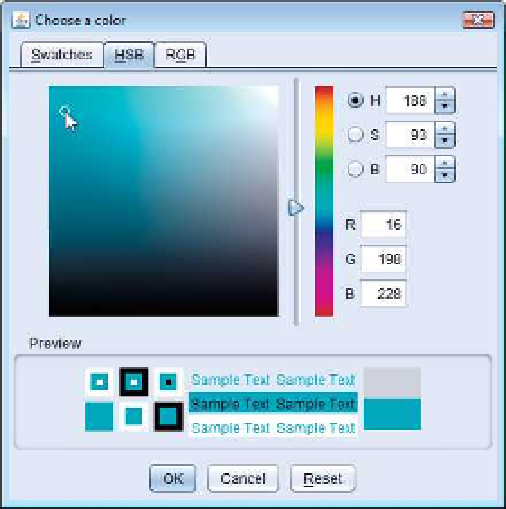Java Reference
In-Depth Information
invoke this method to display the color-chooser dialog. Method
showDialog
returns the
selected
Color
object, or
null
if the user presses
Cancel
or closes the dialog without
pressing
OK
. The method takes three arguments—a reference to its parent
Component
, a
String
to display in the title bar of the dialog and the initial selected
Color
for the dialog.
The parent component is a reference to the window from which the dialog is displayed (in
this case the
JFrame
, with the reference name
frame
). The dialog will be centered on the
parent. If the parent is
null
, the dialog is centered on the screen. While the color-chooser
dialog is on the screen, the user cannot interact with the parent component until the dialog
is dismissed. This type of dialog is called a modal dialog.
After the user selects a color, lines 40-41 determine whether
color
is
null
, and, if so,
set
color
to
Color.LIGHT_GRAY
. Line 44 invokes method
setBackground
to change the
background color of the
JPanel
. Method
setBackground
is one of the many
Component
methods that can be used on most GUI components. The user can continue to use the
Change
Color
button to change the background color of the application. Figure 13.8 con-
tains method
main
, which executes the program.
Figure 13.8(b) shows the default
JColorChooser
dialog that allows the user to select a
color from a variety of
color swatches
. There are three tabs across the top of the dialog—
Swatches
,
HSB
and
RGB
. These represent three different ways to select a color. The
HSB
tab
allows you to select a color based on
hue
,
saturation
and
brightness
—values that are used to
define the amount of light in a color. Visit
http://en.wikipedia.org/wiki/HSL_and_HSV
for more information on HSB. The
RGB
tab allows you to select a color by using sliders to
select the red, green and blue components. The
HSB
and
RGB
tabs are shown in Fig. 13.9.
Fig. 13.9
|HSB
and
RGB
tabs of the
JColorChooser
dialog. (Part 1 of 2.)



